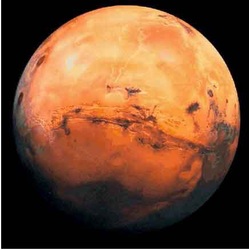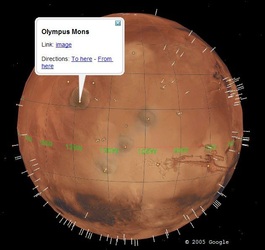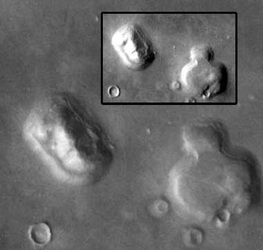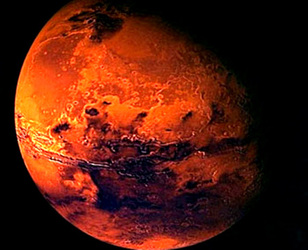Mars
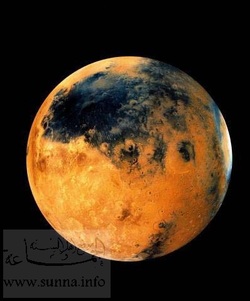
Planet Mars is also called the Red Planet
or Red World.
Mars is reddish in colour and was named after the god of war of the ancient Romans. Mars is the only planet whose surface can be seen in detail from the Earth. Mars is the fourth closest planet to the Sun and the next planet beyond the Earth.
Planet Mars Facts:Number of Satellites: 2 (Phobos and Deimos)
Rotation Period: 24 hours and 37 minutes
Temperature: -140 to 20 degrees celsius (-220 to 60 fahrenheit)
Length of Year: About 1 Earth-year and ten and a half months (687 days)
Diameter: 6796 Kms (4223 Miles)
Axial Tilt: 25.19 degrees
Atmosphere: Mainly Carbon Dioxide
Surface
Mars is a terrestrial planet. It has a hard rocky surface that you could walk on. Mars' surface is dry and much of it is covered with a reddish dust and rocks. Mars has two permanent polar ice caps.
Atmosphere
The Martian atmosphere consists of carbon dioxide (95 percent), nitrogen (2.7 percent), argon (1.6 percent), oxygen (0.2 percent) and trace amounts of water vapor and carbon monoxide.
Gravity
The surface gravity on Mars is only about 38% of the surface gravity on Earth. If you weigh 100 pounds on Earth then you would weigh only 38 pounds on Mars.
Moons:
Mars has two moons and their names are Deimos and Phobos.
Nasa's Mars Robotic Exploration:
Mars was explored in flybys by Mariner 4, 6 and 7 in the 1960s and by the orbiting Mariner 9 in 1971 before NASA mounted the ambitious Viking mission, which launched two orbiters and two landers to the planet in 1975. The landers found no chemical evidence of life. Mars Pathfinder landed on the planet on July 4, 1997, delivering a mobile robot rover that explored the immediate vicinity. Mars Global Surveyor is creating the highest-resolution map of the planets surface.
Russia/Soviets Mars Robotic Exploration:
Started in the 1960's with the Mars Program. The last endeavour by Russia was Mars 96.
More Facts on Planet Mercury - Did you know?
Olympus Mons is the largest volcano in the solar system (550km wide).
The average distance from Mars to the Sun is 228 million km or 1.52 AU.
Mars is reddish in colour and was named after the god of war of the ancient Romans. Mars is the only planet whose surface can be seen in detail from the Earth. Mars is the fourth closest planet to the Sun and the next planet beyond the Earth.
Planet Mars Facts:Number of Satellites: 2 (Phobos and Deimos)
Rotation Period: 24 hours and 37 minutes
Temperature: -140 to 20 degrees celsius (-220 to 60 fahrenheit)
Length of Year: About 1 Earth-year and ten and a half months (687 days)
Diameter: 6796 Kms (4223 Miles)
Axial Tilt: 25.19 degrees
Atmosphere: Mainly Carbon Dioxide
Surface
Mars is a terrestrial planet. It has a hard rocky surface that you could walk on. Mars' surface is dry and much of it is covered with a reddish dust and rocks. Mars has two permanent polar ice caps.
Atmosphere
The Martian atmosphere consists of carbon dioxide (95 percent), nitrogen (2.7 percent), argon (1.6 percent), oxygen (0.2 percent) and trace amounts of water vapor and carbon monoxide.
Gravity
The surface gravity on Mars is only about 38% of the surface gravity on Earth. If you weigh 100 pounds on Earth then you would weigh only 38 pounds on Mars.
Moons:
Mars has two moons and their names are Deimos and Phobos.
Nasa's Mars Robotic Exploration:
Mars was explored in flybys by Mariner 4, 6 and 7 in the 1960s and by the orbiting Mariner 9 in 1971 before NASA mounted the ambitious Viking mission, which launched two orbiters and two landers to the planet in 1975. The landers found no chemical evidence of life. Mars Pathfinder landed on the planet on July 4, 1997, delivering a mobile robot rover that explored the immediate vicinity. Mars Global Surveyor is creating the highest-resolution map of the planets surface.
Russia/Soviets Mars Robotic Exploration:
Started in the 1960's with the Mars Program. The last endeavour by Russia was Mars 96.
More Facts on Planet Mercury - Did you know?
Olympus Mons is the largest volcano in the solar system (550km wide).
The average distance from Mars to the Sun is 228 million km or 1.52 AU.
